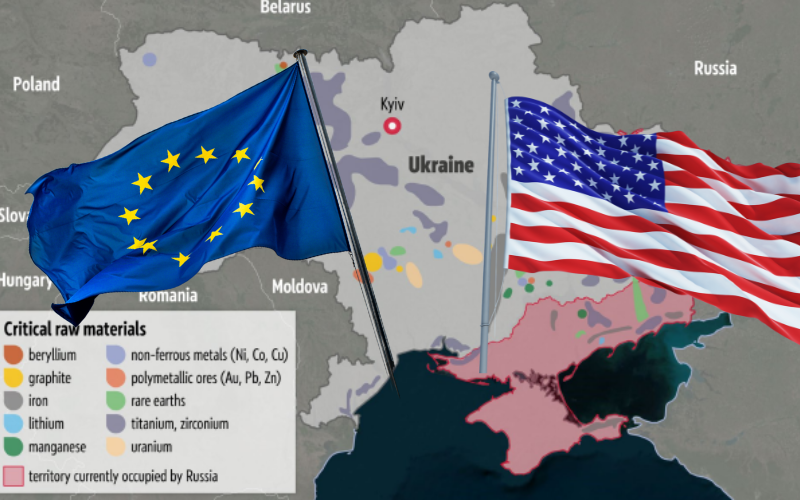As Ukraine grapples with the ongoing conflict with Russia, its vast mineral resources have become a focal point in the global geopolitical landscape. The U.S. and the European Union (EU) are both eyeing these valuable reserves, especially Ukraine’s rare earths, which could play a pivotal role in strengthening their strategic autonomy and reducing dependence on foreign powers such as China.
The Trump administration in the United States has proposed a deal to Ukraine: in exchange for continued U.S. military support against Russia’s aggression, the U.S. would secure a significant portion of Ukraine’s rare earth reserves, estimated at $500 billion. Ukraine, a candidate for EU membership, is also at the center of European strategic plans, with a 2021 agreement aimed at better integrating critical raw materials into EU supply chains. The growing competition for these minerals highlights the EU’s concerns over its current reliance on China, which supplies 98% of the rare earths imported by the union.
A Growing Geopolitical Challenge
In a February 2025 interview, U.S. President Donald Trump outlined his vision for securing $500 billion in Ukrainian rare earths as compensation for ongoing U.S. military assistance. Just days earlier, Ukrainian President Volodymyr Zelenskyy expressed his willingness to negotiate mineral deals with the U.S. as part of a “victory plan” against Russia, which included critical minerals. The Ukrainian government also revealed that it was negotiating deals with several Western allies, including Britain, France, and Italy, to exploit Ukraine’s critical materials.
However, the situation is complicated by Russia’s occupation of significant portions of Ukrainian territory. According to Ukrainian officials, 20% of the country’s minerals and half of its rare earth deposits are under Russian control, while Soviet-era mineral surveys are outdated and fail to account for the economic viability of mining.
US-Ukraine Talks: A Stalled Deal
Efforts to formalize a deal between Ukraine and the U.S. on rare earths hit a snag at the Munich Security Conference in February 2025, when Zelenskyy rejected a proposal to hand over 50% of Ukraine’s rare earth reserves in exchange for military support. While the Ukrainian president agreed to continue talks with the U.S., he emphasized the need for more comprehensive security guarantees. Former Ukrainian Foreign Minister Dmytro Kuleba also stated that the U.S. had no legal claim to Ukraine’s minerals, which were part of a broader strategic partnership with the EU signed in 2021.
Tensions escalated further when Zelenskyy and Trump met at the White House on February 28, 2025. A public argument ensued, and Zelenskyy was reportedly asked to leave, signaling a breakdown in negotiations. By mid-March 2025, the White House announced it had abandoned the idea of a minerals deal, shifting its focus to long-term peace initiatives instead.
The EU’s Strategic Interest in Ukrainian Rare Earths
The EU, for its part, sees Ukraine’s mineral wealth as a critical element in its efforts to reduce dependency on China. The EU’s Critical Raw Materials Act, adopted after Russia’s invasion of Ukraine, aims to address the vulnerabilities exposed by the conflict, particularly in sectors like electric vehicles and renewable energy, where raw materials like nickel and lithium saw significant price increases.
Ukraine holds some of Europe’s largest reserves of essential minerals, including lithium, graphite, titanium, and rare earths such as beryllium, gallium, and uranium. These materials are critical for the EU’s green transition and technological advancement. Ukraine’s minerals could potentially help diversify the EU’s supply chains and bolster its self-sufficiency in critical raw materials, reducing reliance on authoritarian regimes.
In 2021, the EU and Ukraine signed a strategic partnership to foster greater cooperation on raw materials, with a focus on integrating Ukraine’s mining sector into Europe’s battery value chains. However, the Ukrainian mining sector remains underdeveloped, and significant investment is required to unlock its potential. The EU is also concerned with Ukraine’s need to align its mining regulations with European standards as part of its ongoing enlargement negotiations.
Ukraine’s Growing Role in Global Mineral Supply
Ukraine ranks among the top 10 global suppliers of mineral resources, with its mining sector contributing approximately 10% to the country’s GDP and 33% of exports before the war. Mining income has more than doubled since the conflict began, highlighting the sector’s strategic importance. Ukraine also benefits from a skilled workforce, relatively low labor costs, and well-developed infrastructure, making it an attractive destination for mining investments.
Experts suggest that the development of Ukraine’s mining sector, backed by either U.S. or EU support, could play a crucial role in strengthening Ukraine’s economy and defense capabilities while also contributing to Western self-sufficiency and economic security. The prospect of accessing Ukrainian resources could help democratic countries reduce their dependence on non-democratic regimes, particularly in the energy and technology sectors.
The Road Ahead: US vs. EU Influence
As the global competition for Ukraine’s rare earths intensifies, both the U.S. and the EU have stakes in shaping the future of Ukraine’s mining sector. While Ukraine remains a candidate for EU membership, the question remains: which power stands to benefit the most from these valuable resources? Much will depend on how Ukraine navigates its relationships with both powers, as well as the investment strategies and regulatory frameworks that will shape its mineral sector in the years to come.
The geopolitical competition over Ukraine’s rare earths underscores the growing importance of critical raw materials in global power dynamics. As Ukraine continues to recover from the war, its vast mineral reserves could become a key asset for the EU’s quest for strategic autonomy and greater independence from external sources.

